Exploration of Microbially Derived Natural Compounds against Monkeypox Virus as Viral Core Cysteine Proteinase Inhibitors
- PMID: 36680291
- PMCID: PMC9861291
- DOI: 10.3390/v15010251
Exploration of Microbially Derived Natural Compounds against Monkeypox Virus as Viral Core Cysteine Proteinase Inhibitors
Abstract
Monkeypox virus (MPXV) is a member of the Orthopoxvirus genus and the Poxviridae family, which instigated a rising epidemic called monkeypox disease. Proteinases are majorly engaged in viral propagation by catalyzing the cleavage of precursor polyproteins. Therefore, proteinase is essential for monkeypox and a critical drug target. In this study, high-throughput virtual screening (HTVS) and molecular dynamics simulation were applied to detect the potential natural compounds against the proteinase of the monkeypox virus. Here, 32,552 natural products were screened, and the top five compounds were selected after implementing the HTVS and molecular docking protocols in series. Gallicynoic Acid F showed the minimum binding score of -10.56 kcal/mole in the extra precision scoring method, which reflected the highest binding with the protein. The top five compounds showed binding scores ≤-8.98 kcal/mole. These compound complexes were tested under 100 ns molecular dynamics simulation, and Vaccinol M showed the most stable and consistent RMSD trend in the range of 2 Å to 3 Å. Later, MM/GBSA binding free energy and principal component analysis were performed on the top five compounds to validate the stability of selected compound complexes. Moreover, the ligands Gallicynoic Acid F and H2-Erythro-Neopterin showed the lowest binding free energies of -61.42 kcal/mol and -61.09 kcal/mol, respectively. Compared to the native ligand TTP-6171 (ΔGBind = -53.86 kcal/mol), these two compounds showed preferable binding free energy, suggesting inhibitory application against MPXV proteinase. This study proposed natural molecules as a therapeutic solution to control monkeypox disease.
Keywords: antivirals; molecular dynamics; monkeypox virus; natural products; virtual screening.
Conflict of interest statement
The authors declare no conflict of interest.
Figures
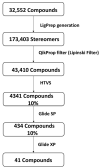
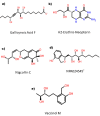
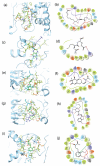

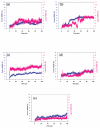

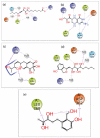
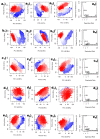
Similar articles
-
Repositioning of anti-infective compounds against monkeypox virus core cysteine proteinase: a molecular dynamics study.Mol Divers. 2024 Dec;28(6):4113-4135. doi: 10.1007/s11030-023-10802-8. Epub 2024 Apr 23. Mol Divers. 2024. PMID: 38652365
-
Screening of potential inhibitors against structural proteins from Monkeypox and related viruses of Poxviridae family via docking and molecular dynamics simulation.J Biomol Struct Dyn. 2024;42(20):10978-10993. doi: 10.1080/07391102.2023.2259489. Epub 2023 Sep 29. J Biomol Struct Dyn. 2024. PMID: 37776002
-
In-silico investigation of E8 surface protein of the monkeypox virus to identify potential therapeutic agents.J Biomol Struct Dyn. 2024 Oct;42(16):8242-8255. doi: 10.1080/07391102.2023.2245041. Epub 2023 Aug 9. J Biomol Struct Dyn. 2024. PMID: 37555596
-
Molecular Virology of Orthopoxviruses with Special Reference to Monkeypox Virus.Adv Exp Med Biol. 2024;1451:111-124. doi: 10.1007/978-3-031-57165-7_7. Adv Exp Med Biol. 2024. PMID: 38801574 Review.
-
A review on computational studies and bioinformatics analysis of potential drugs against monkeypox virus.J Biomol Struct Dyn. 2024 Aug;42(12):6091-6107. doi: 10.1080/07391102.2023.2231542. Epub 2023 Jul 4. J Biomol Struct Dyn. 2024. PMID: 37403283 Review.
Cited by
-
Synergistic anti-inflammatory and anti-tb effects of Au-Pt-Cu nanofluids: experimental and computational insights.Future Med Chem. 2025 Mar;17(6):641-658. doi: 10.1080/17568919.2025.2478818. Epub 2025 Mar 21. Future Med Chem. 2025. PMID: 40114595
-
Investigation of antituberculosis, antimicrobial, anti-inflammatory efficacies of newly synthesized transition metal(II) complexes of hydrazone ligands: structural elucidation and theoretical studies.Sci Rep. 2023 Sep 23;13(1):15906. doi: 10.1038/s41598-023-42180-4. Sci Rep. 2023. PMID: 37741819 Free PMC article.
-
Identification of novel potential inhibitors of monkeypox virus thymidine kinase using molecular docking, molecular dynamics simulation and MM/PBSA methods.Mol Divers. 2024 Aug;28(4):2513-2546. doi: 10.1007/s11030-023-10692-w. Epub 2023 Jul 18. Mol Divers. 2024. PMID: 37462851
-
Synthesis, characterization, and bioactivity of Cu(II), Fe(II), Co(II), Ni(II), and Mn(II) complexes with benzilmonoximethiocarbohydrazide-O-methoxybenzaldehyde: experimental and computational insights.Biometals. 2025 Feb;38(1):245-274. doi: 10.1007/s10534-024-00652-8. Epub 2024 Nov 29. Biometals. 2025. PMID: 39612061
-
Repositioning of anti-infective compounds against monkeypox virus core cysteine proteinase: a molecular dynamics study.Mol Divers. 2024 Dec;28(6):4113-4135. doi: 10.1007/s11030-023-10802-8. Epub 2024 Apr 23. Mol Divers. 2024. PMID: 38652365
References
-
- Multi-Country Monkeypox Outbreak: Situation Update. [(accessed on 5 September 2022)]. Available online: https://www.who.int/emergencies/disease-outbreak-news/item/2022-DON390.
MeSH terms
Substances
LinkOut - more resources
Full Text Sources
Miscellaneous

